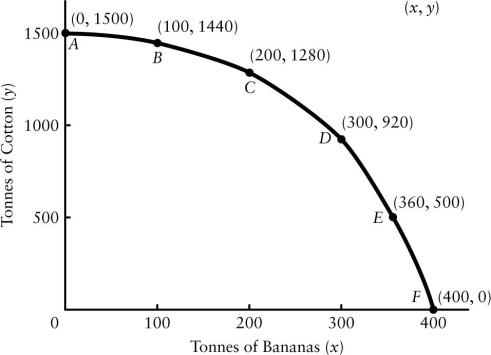Multiple Choice
Figure 1-7 shows the production possibilities boundary for an economy that produces two goods - cotton and bananas.  FIGURE 1-7
FIGURE 1-7
-Refer to Figure 1-7.A production possibilities boundary is shown for an economy that produces two goods - cotton and bananas,both measured in tonnes produced per year.Which of the following statements best describes the difference in opportunity costs that this economy faces at point A compared to point E?
A) The opportunity cost is 1500 tonnes of cotton at point A,compared to 500 tonnes at point E.
B) The opportunity cost is 500 tonnes of cotton at point A,compared to 1500 tonnes at point E.
C) The opportunity cost of producing an extra tonne of bananas is much higher at point A than at point E.
D) The opportunity cost of producing an extra tonne of bananas is much lower at point A than at point E.
E) The opportunity cost of producing an extra tonne of bananas is the same at point A as at point E.
Correct Answer:

Verified
Correct Answer:
Verified
Q1: Suppose Amin has a job that pays
Q28: Suppose you own a courier service and
Q30: Madeleine allows herself $100 per month for
Q33: A greater specialization of labour leads to
Q35: <img src="https://d2lvgg3v3hfg70.cloudfront.net/TB5441/.jpg" alt=" FIGURE 1-5 -Refer
Q36: Economists usually assume that households and firms,respectively,maximize<br>A)income
Q40: Specialization of labour led to greater efficiency
Q57: In practice,the term "centrally planned economy" refers
Q58: Consider Canada's production possibilities boundary.During the nineteenth
Q90: With regard to various economic systems,most economists